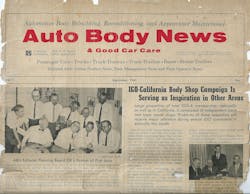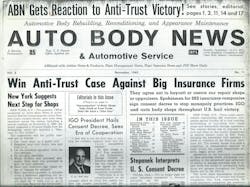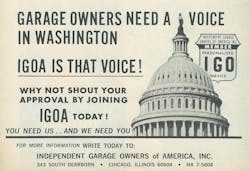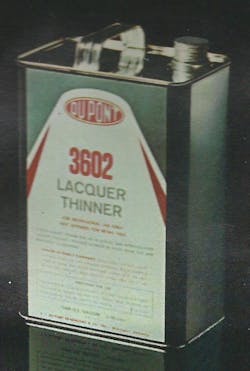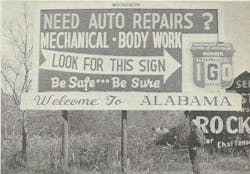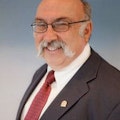YesterWreck – The Column #8: The Collision Repair Industry – 1960 - 1969
Editor's Note: This is the eighth in a FenderBender-exclusive series, excerpted from Ledoux’s book, YesterWreck: The History of the Collision Repair Industry in America, available here. Find the rest of the series here.
Overview
The 1960s in America was a time of lows and highs. One of the lowest lows was the assassination of a young president in Dallas, Texas, followed by a “high” when four young musicians from Liverpool, England, performed to screaming fans on the Ed Sullivan Show a few months later.
It was a time of social and cultural upheaval, of “free love” and “high anxiety.” It was a time of the Cold War and heated, shoe-banging demonstrations at the United Nations. The ‘60s saw “three days of love and understanding” at a music festival in upstate New York, marred at the end of the decade by a death and a brawl at another music festival in Altamont, California. Bob Dylan sang, “The Times They Are A-Changin’,” which was true not just for society but also the collision repair industry.
Three Key Elements of Change
From 1951 to 1963, labor rates increased only about a dollar an hour. Yet, a trade journal touted insurance company adjuster salaries went from $225 per month to $450 per month. A shop owner wrote, “…problems have existed in this business for a long time. We have been talking about them, but what the heck are we doing to correct them!”
In the ‘60s, the collision repair industry experienced three key elements of change almost simultaneously. First, was the evolution and proliferation of auto body associations. Smart shop owners saw which way the wind was blowing and knew they had to band together. Most shop owners had a single shop, maybe two. Alone, they had little clout; a hollow cry in the darkness. Banding together could give them some political power.
The second element was the emergence of leaders. Certain people within the industry began to stand out and assume leadership roles to bring elements of the industry together.
Last, but certainly not least was the advent of the nationally distributed collision repair industry trade magazine. This gave leaders a voice and was a good way to communicate with others in the industry. Industry leaders who were visionaries, with a voice that carried across the country, supported by an organization of astute shop owners was a potent combination. Soon, leaders and those willing to support them had an answer for the shop owner who asked, “…what the heck are we doing to correct…[the industry’s issues]?”
Associations and Bankruptcies
An article in a 1969 trade journal provided one long-time shop owner’s vision of the collision business over the past twenty years. He noted that during the period from 1959-1964, as the collision associations began to emerge, insurance companies began to see them as a threat. They refused to do business with shops that were part of an association or displayed an association emblem on their shop. Some associations were able to put the spotlight on labor rates and the rates increased slightly. However, parts discounts got out of hand, and despite the increased labor rates, shops lost money on parts and many went bankrupt. It is assumed that the same shops that gave away parts were not run well financially, and the parts discounts were the “straw that broke the camel’s back.” During this time, it was also difficult, if not impossible, to recover costs for paint and supplies.
Despite the bankruptcies, more shops opened up. To compete with the established shops, they offered parts discounts and kept the labor rate artificially low. Things got bad – and then got worse for many. According to the veteran shop owner writing the 1969 article, he borrowed $50,000 to stay in business, not knowing how he would pay it back. Shop owners were artisans, not businessmen. From 1964-1969 trade associations became stronger and insurance companies began to accept and even work with the associations to make the industry better, but things did not get better for all shop owners. Due to stiff competition among shops and poor business practices, many owners worked only for a paycheck. These shop owners were not able to provide fringe benefits to their employees. Employees migrated to dealer-owned shops, and other better-run shops that were more profitable and could afford to pay fringe benefits. To try to keep up, many shop owners were working 80 to 100 hours per week.
Pre-OSHA YesterTech
In the 19500s and ‘60s, and even into the ‘70s - the days before the Occupational Safety and Health Administration (OSHA) and the Environmental Protection Agency (EPA) - shops did some radical and dangerous things. Industry veteran Tony Lombardozzi provided some insight.
“Most people were using Amoco white gas in their cars for fuel,” he said. “In the body shops, despite being highly flammable, it made great paint thinner and a wonderful reducer for alkyd enamels like DuPont Dulux. Thinner and reducer was a dollar-plus per gallon. Amoco white gas was 18 cents per gallon.”
Lombardozzi explained that in the late ‘50s and early ‘60s, sheet metal parts such as hoods and fenders were not shipped in cardboard boxes like today. They were covered in Cosmoline because there was no e-coat to keep parts from rusting while being stocked or in transit.
“Cosmoline is a sticky, gooey substance that is difficult to clean off. But white gas did the trickIn fact, it was not uncommon for one guy to be cleaning Cosmoline off a fender with white gas, while another guy was welding only a few feet away, and other guy, also close by, had a car all masked off in highly flammable newspaper. It’s a wonder we didn’t blow ourselves up!”
Bailing Out
With the collision repair industry growing almost unabated since the end of WWII, and the increasing involvement of insurance companies, another trend was starting to emerge by the mid-1960s and continues today to a certain degree – the shop owner who “has had enough.”
Stories like this one started to pop up all over the collision trade magazines: “After running a three-man body shop for over 25 years, Linwood King of Raleigh, North Carolina, was tired of the insurance companies harassing him for parts discounts, asking him to lower his labor rate, asking him to cut corners, and driving customers from his shop. Rather than fight anymore, King stopped doing body work as his main source of business and stopped dealing with insurance companies. Instead, he turned to mostly mechanical work with some small body jobs on the side, small enough that they were customer-pay and did not involve an insurance company. All work was done for cash, on a take-it-or-leave-it basis.”
Most had a similar story – it was tough to get started at first. After things evened out, the shop typically had less business volume, but made more money with less stress and the owner could sleep at night.
Cleaning Up and Calling Out
Throughout the ‘60s, industry leaders called for shop owners to clean up their business and make it more pleasant and aesthetically pleasing to customers and workers. Many owners stepped up and modernized their shop, bringing them out of the ‘40s and into the 1970s.
Meanwhile, shop owners told automakers and insurance executives what to do. Robert Ramsey, a Detroit body shop owner, spoke before a group of over 100 representatives of the auto insurance industry during a convention of the National Association of Independent Insurers in the spring of 1969. He said that the current pricing method used by insurance companies was “retarding the growth” of the industry. He said the current system, used for at least the last 20 years, pits shop against shop so the insurance company can get the lowest price for a job. This meant low profits for the shops, which left no money for training, new equipment or even “normal wage increases” as most industries have.
Ramsay also attacked car makers and called for better designs that were more easily repairable, along with better methods for making needed repairs. He called for car makers to produce more technical data, so the repairer would be up to date on the current technologies, and he called for a better means of parts distribution. Ramsey noted that industry leaders needed to sit down and hash out some of the problems before the federal government stepped in with legislation that nobody wanted.
Excerpted from Ledoux’s book, YesterWreck: The History of the Collision Repair Industry in America available here.
About the Author
Gary Ledoux
A native of New Hampshire, Gary Ledoux retired in 2017 after a 48-year career in the automotive industry. For 18 years, he worked in various capacities in numerous car dealerships in New Hampshire. In 1988, Gary began his career with American Honda, eventually serving as the assistant national manager for American Honda’s Collision Parts Marketing Department, and was instrumental in launching Honda’s certified body shop program. He was very active in the collision repair industry, serving on various Collision Industry Conference (CIC) committees and as a three-time chairman of the OEM Collision Repair Roundtable. Today, Ledoux is a freelance writer splitting his time between his Florida home and vacation property in South Carolina. In the summer of 2018, he published his fifth book, YesterWreck: The History of the Collision Repair Industry in America.
